|
George
Cupples was born in 1822 at Legerwood manse,
Berwickshire, son of Free church minister George Cupples
(1786–1850). He was educated at Stirling and apprenticed
to a Liverpool shipowner. After an eighteen-month voyage
to India his indentures were cancelled and he studied
divinity at Edinburgh University. In 1858 he married
Anne Jane Douglas (1839–1898), daughter of Archibald
Douglas of the general post office in Edinburgh and
herself the author of fifty books for children. George
Cupples wrote dozens of nautical novels, such as The
Green Hand: A Sea Story (1856), The Two Frigates: or,
Captain Bisset's Legacy (1859), and Captain Herbert: A
Sea Story (1864). In addition, Cupples produced 254
tales and articles for Chambers's Edinburgh Journal,
Blackwood's Magazine, Fraser's Magazine, Macmillan's
Magazine, and others. Near the end of his life, his
literary friends presented Cupples with an annuity bond
of £30. He died in 1891 at the Admiralty House,
Newhaven.
The Green Hand
Anne Jane Cupples, née Douglas (4 January 1839 – 14 November 1896) was a Scottish writer and populariser of science. She was married to the dog-breeder and writer George Cupples, and after his death moved to be with her sisters in New Zealand, where she died in 1896. She wrote around fifty books in total, mostly intended for children, under the name Mrs George Cupples.
Norrie Seton
By Mrs George CupplesThe Adventures of Mark Willis
By Mrs George Cupples Genealogy
of George Cuppers
Marriage of George Cuppers
to Sarah Turnbull
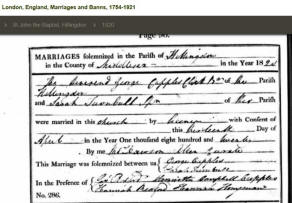
1830's More Cuppers Births
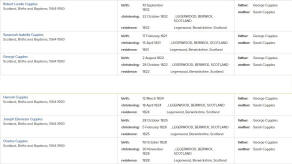
1822 Birth of George Cupples
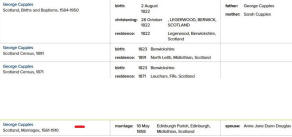
George Cupples in the 1851
census
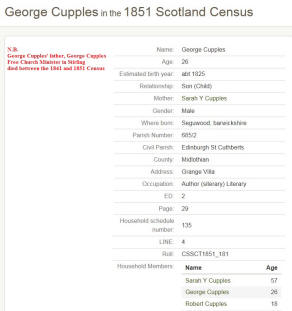
1858 Marriage of George
Cupples to Ann Jane Dunn Douglas
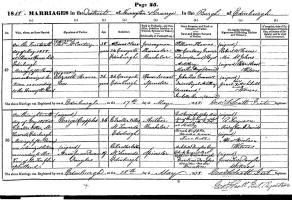
George Cupples in the 1861
Census
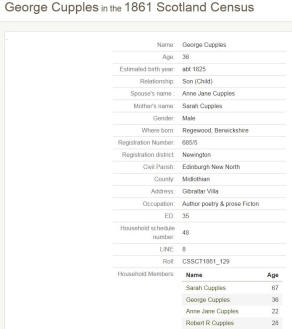
Death of Sarah Cupples
%20Cupples_small.jpg)
George Cupples in the 1881
Census
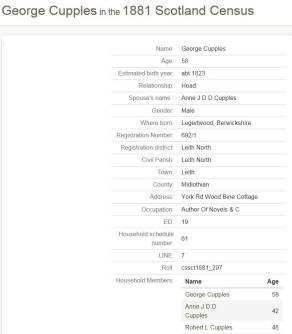
George Cupples in the 1891
Census
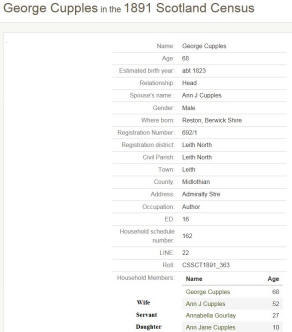
Death of George Cupples
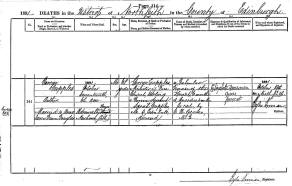
George Cupples 1841 Census
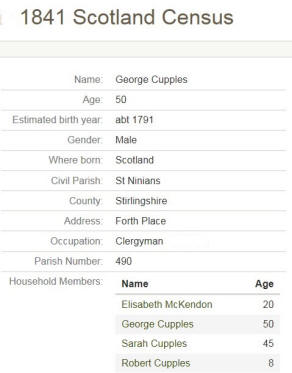
Cupples - Other Data
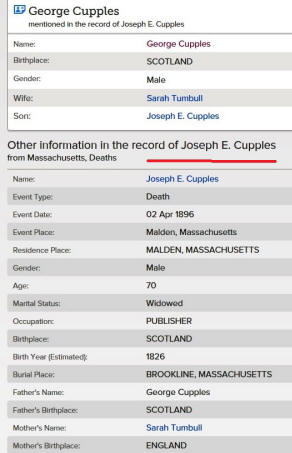 George
Cupples (1822–1891)
Critical and Biographical Introduction by Bartleby and
Company
George
Cupples was born at Legerwood, August 2nd, 1822, and
died October 7th, 1891. His father was a minister of the
Free Kirk, and his paternal ancestors had been
Calvinistic ministers for at least three generations. It
was natural that the young man should be intended for
the same profession, but he did not feel drawn to it,
and when about seventeen went to sea for two years.
Although of a firm physical constitution, the life of
the seaman wearied him, and he resumed his education at
the University of Edinburgh. He fell naturally into a
literary career, and though much of his work was
journalistic, he was reckoned in his day a critic of
true insight. His novels are his best title to
reputation, and show a vein of genuine creative power.
Cupples combined some of the sterling and attractive
traits of the cultured Scotchman of the period into a
genuine, manly, and winning personality. Though slightly
whimsical, his peculiarities were of the kind that
endear a man to his friends; and Cupples numbered among
his, Dr. John Brown, Dr. Stirling, Blackwood, and many
others of the cultivated Scotchmen of the period.
‘The
Green Hand,’ which came out in Blackwood from 1848 to
1851, is one of the best sea stories ever written. If we
put Stevenson’s ‘Treasure Island’ first for balance of
description and narration, and sureness in the character
touches, ‘The Green Hand’ and ‘Tom Cringle’s Log’ are
close seconds. Cupples’s book is perhaps slightly
overloaded with description, and deficient in technical
construction as a narrative; but it is nevertheless a
story which we read without skipping, for the
descriptive pages are highly charged with the poetic
element, and bear the unmistakable marks of being based
on actual observation. Life in a sailing vessel has
closer contact with the elemental moods of nature than
in a steamer, where the motive power is a mechanical
contrivance with the tiresome quality of regularity. To
be in alliance or warfare with the wind, and dependent
on its fitful moods, brought an element of variety and
interest into the seaman’s life which steam navigation,
with its steadily revolving screw and patent valves,
must always lack. Of this Cupples avails himself to the
fullest extent; and it would be difficult to find a
better presentation of the mysterious life and vastness
of the ocean, and of the subtle impression it makes on
those brought in daily contact with it, not excepting
Victor Hugo’s ‘Toilers of the Sea.’ This is due to the
fact that he spent two years before the mast when a
young man. Especially noticeable too is his admirable
use of adjectives denoting color, which are descriptive
because they image truly the observations of a man of
genius, and are not, as in so much modern writing,
purple patches sewed on without any real feeling for the
rich and subtle scheme of nature. In calling up to the
imagination the sounds of the sea,—the creaking of the
blocks, the wind in the rigging, the wash of the water
on the sides, the ripple on the bow, and the infinite
variety of the voice of the waves,—Cupples shows true
poetic power. It is not too much to say that ‘The Green
Hand’ does not suffer from the fact that one of the
parts stands in the magazine in juxtaposition to De
Quincey’s ‘Vision of Sudden Death.’
‘Kyloe
Jock and the Weird of Wanton-Walls’ is a transcript from
the boy life of the author. It appeared in Macmillan’s
Magazine, in the autumn numbers of 1860. It is but a
short sketch of a group of simple people in a secluded
border parish, but the quality of the writer is shown as
well in small things as in great ones. In it the wintry
scenes especially are given with broad and sure touches,
for the author is a genuine lover of nature; but the
characters of Kirstie the nurse, and of Kyloe Jock, the
half-savage herd-boy who knows so well the wild
creatures of the woods and fields that he has even given
names to the foxes, show the feeling for human nature
and the ability to embody it which marks the artist.
Kyloe Jock’s Scotch is said to be an absolutely perfect
reproduction of the vernacular; and it might be said
that this book, like some of our modern Scotch stories,
would be better if the dialect were not quite so good.
The
peculiar qualities of the author are not seen to such
good advantage in another book of his, ‘Scotch
Deerhounds and Their Masters.’ He was a breeder and
unquestioned authority on the “Grand Dog,” and
accumulated a store of curious information on its origin
and history; but his enthusiasm for this noble breed, or
“race” as he loves to call it,—and it certainly is the
finest and most striking of all the varieties of the
“friend of man,”—led him into some strange vagaries. One
would almost suspect him of holding the theory that dogs
domesticated man, so high does he rank them as agents of
early civilization. His etymology and his ethnology are
alike erratic. He holds that every ancient people in
whose name can be found the combinations “gal,” “alb,”
or “iber,” or any other syllable of a Celtic word, was
of the Celtic family, and that the Scotch deerhound and
the Irish greyhound are descendants of the primeval
Celtic dog. In this way he proves that the Carthaginians
and the shepherd kings of Egypt were undoubtedly Celts,
for their sculpture shows that they hunted with large
swift dogs that sprang at the throat of their prey. On
the other hand, every tribe that owned large clumsy dogs
that barked is probably non-Celtic. Mr. Cupples’s
contempt for such dogs is too intense for definite
statement, and he evidently thinks that the tribe that
owns them cannot hope to rise very high in the scale of
civilization. This is certainly Philo-Celticism run mad,
and is the more remarkable because Mr. Cupples could
discover no Celtic strain in his own ancestry. He gave
his dogs, however, Celtic names, as Luath, Shulach,
Maida, Morna, Malvina, Oscar, etc. It would have been
quite impossible for him to disgrace one of his “tall,
swift, venatic hounds” with so Saxon a name as Rover or
Barkis. But his enthusiasm is so genuine, and there is
such a wealth of curious information in his pages, that
his book has a charm and a substantial value of its own.
The other
work of Mr. Cupples was, like that of most of the
journalistic men of letters of the period, largely
anonymous. His essay on Emerson, contributed to the
Douglas Jerrold’s Magazine, is very highly spoken of.
Personally, Mr. Cupples must have been a man of great
simplicity and charm, a happy combination of the genuine
and most agreeable traits of that hearty and outspoken
variety of man, the literary Scotchman.
Kyloe
Jock and the Weird of Wanton-Walls
[serialised in MacMillan’s Magazine Volumes Two and Three in 1860]
Chapters 1 - 2
Chapters 3 - 4
Chapters 5 - 6


The Sunken Rock Mrs
George Cupples was born Ann Jane Dunn Douglas, on 4
January 1839 at 34 Gilmore Place, Edinburgh, Scotland.
Geneaolgy
A
monograph, written by her Grand niece, Elspeth White.
She was the third of the seven children of Archibald
Douglas of Morton and his wife, Caroline Montague Scott
Prentice, daughter of Captain Ebenezer Prentice of the
Scots’ Fusiliers. Archibald Douglas also came from a
military background but he had joined the Civil Service
and was destined for a post in New Zealand, when he died
suddenly at the age of fifty-five. His widow, who must
have been a woman of great strength and ability, decided
to proceed to New Zealand as planned. She arrived in
Dunedin in 1858 where she opened a small school near
Pelichet Bay.
Caroline Douglas took five daughters to Dunedin with
her, leaving in Edinburgh her only son who followed
later and her daughter, Ann Jane about whom this
monograph is written. At this time Ann Jane was nineteen
years of age and George Cupples was thirty-six and one
of the most respected literary figures of Edinburgh. He
was a noted contributor to Blackwood’s Magazine, an
essayist and author of novels, including The Green Hand,
a best-selling novel of the sea which went into five
editions between 1856 and 1908.
So it was to a literary lion that the nineteen-year-old
Ann Jane was married, and is it any wonder that her
first books to be published were simply under the
initials A.J.C.? Bearing in mind that it was customary
for women authors of Victorian times to use their
husband’s names, it is not surprising that she later
published as Mrs George Cupples; although there may have
been also an element of expediency in being able to make
use of such a prestigious name in the publishing world.
George Cupples was in his other capacity a famous
breeder of Scotch deer hounds, said by him to be ‘one of
the noblest races of quadrupeds ever known’ -and I
imagine, of the canine race, one of the most alarming.
After George Cupples died in 1891, his wife edited and
published his life’s findings on these dogs in a lavish
illustrated book of over three hundred pages called
Scotch Deer hounds and their Masters. And it was
obvious, from references in her stories to these dogs,
that she shared her husband’s love of this noble race of
quadrupeds.
Ivan Illich has said that children were a nineteenth
century invention. Before that they were regarded as
incipient adults. Women authors took up their pens in
droves to write for this delightful invention. Mrs
Cupples must have been one of the more prolific of these
women writers for children, for the British Library at
the British Museum holds forty-eight of her books. A
list of these with sub-titles, publishers and dates of
publication is attached. I would like to single out some
titles as they relate to the author’s life.
It would appear from the British Library list that Mrs
Cupples’ first book to be published was Unexpected
Pleasures or, Left Alone in the Holidays. Here she uses
the technique, popular at the time, of a secondary title
which gives the purchaser some idea of the trend of the
book - and the readers a hint of the message for them.
This book was published by W.P. Nimmo, Edinburgh in
1868. This date is interesting. It was exactly ten years
since the Cupples were married. Ann Jane was twenty-nine
years old and it may have been that she realised that
she was not going to have children and that she was
looking for a productive means of filling in her time by
writing for other people’s children.
The next year, 1869, saw the publication of her
full-length novel for boys, Norrie Seton or, Driven to
Sea, published by W. P. Nimmo, Edinburgh. This was a
good yarn and must have been popular, for Nimmos brought
out a very fine new edition in 1896.
In this book, as in all her sea stories, Mrs Cupples
must have drawn almost completely on her husband´s early
experiences at sea, so at this point it would be helpful
to consider the young George Cupples.
He was born in 1822, and his father was the minister of
Legerwood, a small parish just north of Melrose in the
Scottish county of Berwick. George’s first lessons were
from his father but, at the age of ten he went to
school, walking five miles each way in all weathers.
When he was twelve, his family moved to Stirling and,
reading between the lines of the discreetly-guarded
Memoir written by Dr James Hutchinson Stirling, it
becomes apparent that he got into some sort of trouble
with a rowdy element in the town. It seems that he was
so afraid of his father’s anger that he ran away to sea.
The Memoir is less guarded in its description of
George’s father: ‘.. a terrible father, and in his
Covenanting Calvinistic rigidity and strictness, a
perfectly awful man.’
A life on the ocean wave seemed to be the only escape
(and indeed, it was the traditional escape in those
days), but it proved to be even worse than life at home
with his father. Poor George could not take the crudity
and the terrible hardships of sailing-ship life, and
after eighteen months plying the trade route to India,
he came home in a state of ‘penitential cowedness’, as
his brother described his condition. He begged his
father to have his indentures cancelled, in other words
to buy him out of the service. This ‘the awful man’
fortunately did, and for the next eight years George
studied at Edinburgh University.
It would seem obvious that Mrs Cupples’ sea story Norrie
Seton; or, Driven to Sea, was certainly inspired by the
unfortunate circumstances of her husband’s teenage
years. In this book it is Major Seton, the over-strict
uncle, who drives the young hero to sea. Like George
Cupples, Norrie Seton had had a scrape with the local
police and, although not the guilty one, his refusal to
tell on his friends caused his uncle to chastise him
unmercifully.
Norrie runs away and joins the ship ‘Vulcan’, bound for
San Francisco. It is obvious from the beginning that
Norrie, unlike George Cupples, is going to make a
success of the venture. He put up with the injustices
imposed on him by a bullying second mate, never losing
his stoic calm. He sang sea-shanties admirably, so
winning a great following among the sailors. He sorted
out a dirty situation with some mutineers, saved people
who fell overboard, and ended his first voyage a
competent apprentice with a letter from his captain to
say so.
The circumstances of going to sea and the experiences
suffered at sea were similar in the cases of both the
author’s hero, Norrie Seton and her husband, George
Cupples. Their return home, however, could not have been
more different - Norrie Seton to the warm embrace of an
apologetic uncle and an admiring family circle; George
Cupples in a ‘state of abject cowedness’ to his terrible
father, to be bought out of the Service as a failure. It
was almost as if Mrs Cupples could not bear the
unkindness meted out to her husband and so decided to
write his story differently.
1869 was an important year for Mrs Cupples for not only
did she publish Norrie Seton, but in that year she was
discovered by the publishers T. Nelson & Sons, London.
During that year Nelsons published her books Alice
Leighton; or, A Good Name is rather to be chosen than
riches;, Carrys Rose; or, The Magic of Kindness; and
Hugh Wellwoods Sucess; or, Where Theres a Will Theres a
Way.
The partnership with Nelsons was to prove a happy one,
and in all they published twenty-six of her titles.
George Cupples must have encouraged his wife in this
profitable pursuit, and it is pleasant to picture the
husband and wife sitting by the fire checking
manuscripts with a deer-hound or two spread between them
on the hearth-rug.
The next year brought more sea stories from Mrs Cupples’
pen. Bill Marlin’s Tales of the Sea, Johnstone, Hunter &
Co, Edinburgh, although undated is given the date 1870
in the British Library catalogue. This book is
dedicated as follows:
To
My Two Little Sisters
In New Zealand
H. & J.
These Tales are
Affectionately Inscribed
Her two
little sisters were by that date nineteen and twenty-one
years respectively. ‘H’ was to become Mrs Helen Hutton
and ´J´, Mrs Janet Ramsay (my grandmother), both of whom
lived and died in Dunedin.
So it can only be assumed that Mrs Cupples wrote these
stories for the little sisters she missed so much and
sent them in manuscript form to New Zealand, leaving the
inscription intact when the books were finally published
in 1870.
Bill Marlin’s Tales contains two long stories and in
both of them Mrs Cupples uses one of her husband’s
literary devices. In his novel The Green Hand, George
Cupples tells his story through a ship’s captain
reminiscing with his passengers in the saloon after
dinner during a long voyage. Mrs Cupples, writing for
children, uses the same technique, but has Bill Marlin,
an old seaman, as the narrator telling stories to his
grandchildren by the fire before they go to bed. Indeed,
she uses this method often of an older person telling
the child a story.
The first of Bill Marlin’s stories, Miss Matty: or, Our
youngest passenger, tells of a very nice little girl
travelling to England from India after the death of her
mother. During he voyage, she manages to civilise the
rather wild crew of the good ship ´Mersey´, and to keep
their spirits up while they spent a miserable time
shipwrecked on an uninhabited island. Her optimism was
not misplaced - rescue was at hand.
The second story is interesting in that again, as in
Norrie Seton, Mrs Cupples uses her husband’s unfortunate
experiences. Like George Cupples, the hero of The Little
Captain, Midshipman Charles Harvey, was the son of a
clergyman and of a religious nature. Because he read his
Bible regularly, he was ridiculed unmercifully and
treated with both physical and mental cruelty by the
officer of his watch and his fellow apprentices. Again
we see Mrs Cupples’ determination to turn her husband’s
failure at sea into a success story. In this book, the
ordinary seamen recognise Charles Harvey’s worth, and to
them he is known as ‘the little captain’. When he goes
ashore at Mozambique to save some of his shipmates baled
up by the natives, he receives a fatal stab wound. His
death turns him into a classical hero.
The Little Captain was also brought out by Johnstone,
Hunter & Co under that title along with Gottfried of the
Iron Hand: a Tale of German Chivalry. This is a similar
edition to Bill Marlin’s Tales, and also has the
dedication to her little sisters in New Zealand but the
author styles herself ‘A.J.C.’, not Mrs George Cupples,
as in the companion volume. This makes one wonder if it
could be earlier.
The Little Captain must have been a very popular story
because it was published again in 1885, this time by
Gall & Inglis, London, Edinburgh. Lists show some five
more titles in second editions. Alf Jetsam, Blackie &
Sons, London, 1886, was brought out again by Blackies in
an abridged edition as late as 1933.
Animal stories came second to the sea as a favourite
subject for Mrs Cupples and, provided one can understand
the Scottish dialect she employed, one of her most
delightfully amusing books about animals is Tappy’s
Chicks, Strahan & Co, London, 1872. This book has the
sub-title, Links between Nature and Human Nature, and it
contains twelve stories about such diverse creatures as
ferrets, pigs, monkeys, ducklings and her beloved dogs -
the best and funniest is about The Laird’s Staghound.
In her writings her delight in animals is obvious. In
all Mrs Cupples’ books, that I have seen, both at the
Dorothy Neal White Collection at the National Library,
Wellington, and in my own collection, there is hardly a
story in which some particularly pleasant dog does not
appear.
I have said that many of her books were published by T.
Nelson & Sons. Most of these were instructive, and many
had the moral tag demanded so often by Victorian
publishers. The following titles show this trend: Bertha
Marchmont: or, All is Not Gold that Glitters; Bluff
Crag: or, A Good Word Costs Nothing; Carry’s Rose; or,
The Magic of Kindness.
But even Nelsons gave her her head and allowed her her
humour every now and then. In The Cockatoo’s Story, T.
Nelson & Sons, Paternoster Row, 1881, for instance, we
meet a wise old parrot who had been, by a twist of
irony, ‘the favourite Polly of an old bird-stuffer’ and
also a macaw, the Great Mogul, who had learned so many
bad words from his previous sailor owner that he had to
be segregated from the parrot for fear of moral
contamination.
In those days when government help for the poor was
minimal, Mrs Cupples gave a lot of her time to social
work for the underprivileged. She aroused a great deal
of public interest in the founding of a home for the
training of orphan girls and boys from Glasgow. This
home, erected by public subscription, was situated on
Duchray Water, Aberfoyle. She was also a member of the
committee of the Edinburgh YWCA.
However, her social work at Newhaven probably showed her
compassion most markedly. Newhaven is a fishing village
near Edinburgh and here the fishwives worked on the
wharf where the herring fleet came in, cleaning and
scaling the fish as the great baskets were brought out
of the boats. It was an appalling and filthy job for
these women, working in the bitter winds off the North
Sea, their hands chapped and bleeding from the constant
contact with the salt and the awful cold. Here Mrs
Cupples went to work among these women as a voluntary
social worker, organising what practical help she could
for them and giving then the support of her friendship.
The depth and sincerity of their love and gratitude was
shown when, some 15 years after Mrs Cupples left
Scotland for New Zealand, my mother (her niece) visited
Scotland and called at the wharf at Newhaven to see the
scene she had heard about from her aunt. The fishwives
were still there and when my mother told them that she
was the niece of Mrs Cupples, she was surrounded by
tearful women all wanting to embrace her. She ended up,
according to reports, covered in scales, smelling very
fishy, but inordinately proud of her aunt.
On 17 October 1891, George Cupples died aged 69 years,
and three years later Mrs Cupples decided to join her
sisters in New Zealand. She sailed from Plymouth in RMS
´Gothic´ for Port Chalmers, arriving there on 14
November 1894. She spent the next four years living with
her unmarried sisters, Margaret and Caroline Douglas who
lived at Mosgiel, near Dunedin.
Mrs Cupples died at Mosgiel on 19 November 1898, aged 59
years, and the only obituary notice was in the Taieri
Advocate of 23 November 1898, which read as follows:
‘… she was a lady of considerable literary ability, and
when in good health was a contributor to Home journals.
For a long time she conducted a ladies column in the
Taieri Advocate, her nom de plume being Penelope.’
It seemed sad that this energetic and talented writer
with a distinguished record of publications in England
and Scotland should only be known in New Zealand as a
contributor to ladies’ journals.
For that reason I was prompted to write this monograph,
and I hope it may prove useful to anyone who is
interested in the significant collection of the books of
Ann Jane Cupples in the Dorothy Neal White Collection.
Carry's Rose or, the Magic
of Kindness. A Tale for the Young
Mrs. George Cupples (1881) (Text File)
The Cockatoo's Story
Mrs. George Cupples (1881) (Text File)
Bluff Crag or, A Good Word Costs
Nothing
Mrs. George Cupples (1872) (Text File)
Singular Creatures and
How they were Found
Being Stories and Studies from the Zoology of a Scottish
Parish
Mrs. George Cupples (1872) (pdf File)
My Pretty Scrap-Book
Picture Pages and Pleasant Stories for
Little Readers
Mrs. George Cupples (1874) (pdf File)
Bibliography
A History of the Douglas Family of Morton (Dumfriesshire)
and their Descendants, Percy W.L. Adams. Privately
published. The Sydney Press: Bedford. 1921
Scotch Deer Hounds and their Masters. George Cupples,
with biographical sketch by James Hutchinson Stirling,
LLD, Wm Blackwood & Sons: Edinburgh & London. 1894
BOOKS BY MRS CUPPLES HELD IN THE DOROTHY NEAL WHITE ROOM
INTRODUCTION
Through the generosity of the descendants of Mrs Cupples’
brothers and sisters the Children’s Historical
Collection contains twenty-three of Mrs Cupples’ books.
We are extremely fortunate to have these books as they
are significant for a variety of reasons.
First of all, there is the New Zealand connection
explained in Elspeth White’s memoir. While none of these
books was written in New Zealand, Mrs Cupples kept in
close touch with her family and joined them for the last
four years of her life.
In addition, her writings are a valuable resource for
any student of Victorian children’s literature. Mrs
Cupples is an excellent example of the professional
woman writer of the period. Her writing style is an
accomplished one and she could turn her hand to whatever
the market required. Consequently her range of books
represents a microcosm of popular genres in children’s
writing of the mid-Victorian period. For older readers
she produced tales of nautical adventure and
Robinsonnades. Moral tales and natural history stories
were written for a variety of age‑groups.
Some of her best stories about animals make good use of
her intimate knowledge of Scottish working life. She
also produced a number of ‘picture page’ books for the
very young, writing stories, to fit illustrations
supplied by the publisher.
The topics and themes she chose are typical of what was
considered suitable for young readers in this period.
Within this framework her characters are often robust
and adventurous, and humour as well as piety can be
found.
Mrs Cupples was well‑served by her publishers who
ensured a good standard of illustration and binding for
her books. Their decorative and often pictorial covers
made them among the most attractive books of their era
in the collection. Displayed together they provide the
onlooker with an overview of many key features of
publishing for children in the 1870s.
BIBLIOGRAPHY
The adventures of Mark Willis London : Nelson, 1872
168p. Coloured frontispiece. Engraved illustrations.
Inscribed ´To Mr Robert L Cupples with the authors
kindest regards 27th Nov 1873.
The adventures of Mark Willis London : Nelson, 1897
167p. Pictorial cover. Frontispiece missing
Bill Marlin’s tales of the sea. Edinburgh : Johnstone,
Hunter, 1870 Comprises two stories: Miss Matty: or, our
youngest passenger 145p. and The little captain: a tale
of ‑the sea, 96p. Carries the printed dedication ´To my
two little sisters in New Zealand H & J, these tales are
affectionately inscribed.´
A book about house work: a convenient manual for
mistresses and maids with useful hints and receipts in
the various departments of housekeeping. 3d ed.
Edinburgh: J. Menzies, 1878. 96p. Paperbound.
Edenside: the lights and shadows of our village
Edinburgh : The Religious Tract and Book Society of
Scotland, 1881. 163p. Engraved illustrations.
Helpful words from a barn door Edinburgh: John Maclaren,
1879. 19p. A threepenny religious tract.
The hidden talent: or, use in everything London: Nelson,
1875. 61p. Pictorial cover. Engraved illustrations.
Hugh Wellwood’s success: or, where there’s a will
there’s a way London Nelson, 1869. 48p. Engraved
illustrations.
Katty Lester: a book for girls London : Marcus Ward,
1873. 118p. The chromographs are facsimiles of the
original drawings made for Vere Foster, Esq., by
Harrison Weir.
The lost rabbit: or, look at everything and touch
nothing. London: Nelson, 1875. 61p. Engraved
illustrations.
Mamma’s stories about domestic pets London: Nelson,
1876. 168p. Pictorial cover, red binding. Engraved
illustrations.
Mamma’s stories about domestic pets. London : Nelson,
1876. 168p. Pictorial cover, green binding. Engraved
illustrations. This copy is sub‑titled about wild
animals on cover, perhaps through a bindery confusion
with Talks with Uncle Richard about wild animals issued
in identical binding the same year.
My pretty scrap‑book: or, picture pages and pleasing
stories for little readers. London: Nelson, 1883. 92p.
Pictorial cover. ´With eighty‑two illustrations´.
Includes on p.79 ´A New Zealand chief´
Norrie Seton: or driven to sea Edinburgh: William P
Nimmo, 1869. 422p. Engraved illustrations. Publishers
catalogue for 1871 appended.
Our parlour Panorama London: Nelson, 1882. 92p.
Pictorial cover. “With eighty‑two illustrations”.
Singular creatures and how they were found: being
stories and studies from a domestic zoology of a Scotch
Parish Boston: Lee and Shepard, 1872. 333p. US edition
of Tappy’s chicks. Inscribed ´To the author Mrs George
Cupples with the affectionate regards of her nephew J.G.
Cupples Boston, Mass. USA May 23/78´.
Talks with Uncle Richard about wild animals London:
Nelson, 1876 167p. Pictorial cover Engraved
illustrations.
Tappy’s chicks: Sep/75 and other links between nature
and human nature London Strahan, 1872 321p. ´With
nineteen illustrations´. Inscribed ´To my beloved mother
from her affectionate daughter The Author, 2nd April
1872´
Terrapin Island: or adventures with the ´Gleam´
Edinburgh: Gall & Inglis, 1876 288p. ´Eight woodcuts´
Tim Leeson’s first shilling: or, try again London:
Nelson, 1875. 64p. Engraved illustrations.
Walks and talks with Grandpa London: Nelson, 1876. 120p.
Pictorial cover. Engraved illustrations.
Young bright‑eye: or, Charlie Harvey’s first voyage
Edinburgh: Gall & Inglis, 1875. 224p. ´Four full‑page
cuts´. 2 copies. One is inscribed ´To Archie D Burns
from his aunt wishing him many happy returns of his
birthday 29th Sep/75´
Also held in the Dorothy Neal White Room are three books
by Mr George Cupples, the authors husband: Sep/75
Cupples Howe, mariner: a tale of the sea Boston: Cupples,
Upham, 1885. 258p.
The green hand: adventures of a naval lieutenant: a sea
story for boys London: Routledge, 1879. 448p. Engraved
illustrations. Preface dated 1878 states this is a
´revised edition, freed from various expressions now to
a certain extent obsolete or otherwise unsuitable, so as
to make it more thoroughly fit for juvenile readers´
Sep/75
The two frigates London: Routledge, 1859. 387p. This
edition issued as part of 'Routledge’s Railway Library´
|

